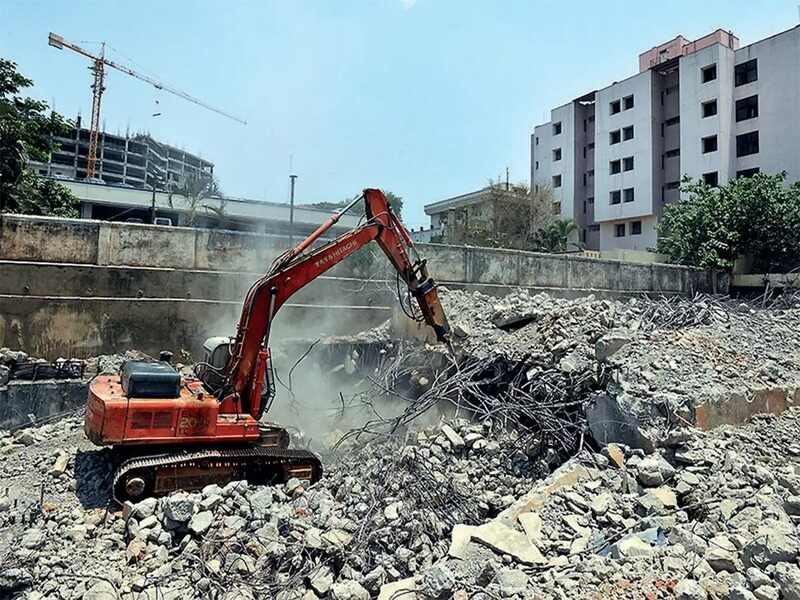The government of India has released comprehensive guidelines for effective disposal of construction and demolition (C&D) waste in the country. The guidelines were announced at the National Workshop on “Recent Development with recycling and use of C&D waste in construction sector” held on 19th February 2024. The workshop was inaugurated by Shri Hardeep Singh Puri, Minister of Housing & Urban Affairs and Petroleum & Natural Gas.
What is C&D waste?
C&D waste is the waste comprising of building materials, debris and rubble resulting from construction, remodeling, repair and demolition of any civil structure. It is estimated that India generates about 150-500 million tonnes of C&D waste every year, which poses many challenges such as unauthorized dumping, lack of space for disposal, and improper mixing with biodegradable waste.
What are the key features of the guidelines?
The guidelines, notified by the Ministry of Environment, Forest and Climate Change (MoEFCC) in 2016, provide a regulatory framework for management of C&D waste in the urban areas of the country. Some of the key features of the guidelines are:
- Every waste generator shall segregate C&D waste into four streams: concrete, soil, steel, wood and plastics, bricks and mortar.
- Every waste generator shall pay relevant charges for collection, transportation, processing and disposal as notified by the concerned authorities.
- Waste generators who generate more than 20 tons or more in one day or 300 tons per project in a month shall have to submit waste management plan and get appropriate approvals from the local authority before starting construction or demolition work.
- The local authority shall establish a system for collection and transportation of C&D waste either directly or through authorized agencies.
- The local authority shall identify suitable sites for processing and disposal of C&D waste in consultation with the state pollution control board or pollution control committee.
- The local authority shall promote the use of recycled products made from C&D waste such as aggregates, bricks, tiles, pavement blocks etc. in various construction activities.
- The local authority shall create awareness among the public and stakeholders about the benefits of C&D waste management and recycling.
What are the benefits of C&D waste management and recycling?
C&D waste management and recycling can have significant economic, social and environmental benefits such as:
- Saving natural resources and reducing the demand for raw materials
- Reducing greenhouse gas emissions and air pollution
- Creating employment opportunities and income generation
- Improving public health and sanitation
- Enhancing aesthetic value and livability of urban areas
How can you contribute waste management and recycling?
You can contribute to C&D waste management and recycling by:
- Following the guidelines and rules issued by the government and local authorities
- Segregating C&D waste at source and disposing it properly
- Choosing recycled products made from C&D waste for your construction needs
- Supporting initiatives and innovations that promote C&D waste management and recycling
What did the minister say about C&D waste management?
The minister highlighted the vitality of construction industry for Indian economy and said that it is among the fastest growing industries in India. He said that India needs to add about 700-900 million sq. metres of commercial and residential space every year by 2030. He also acknowledged the environmental considerations especially C&D waste associated with construction sector. He said that with increasing construction activity, it is imperative to find more efficient solutions to manage the C&D waste that will arise.
He said that construction and demolition waste is one of the largest solid waste streams in the world. He said that as per estimates, the construction industry in India generates about 150-500 million tonnes of C&D waste every year. He said that this brings many challenges to the forefront such as unauthorised dumping, a lack of space for disposal, and improper mixing with biodegradable waste. He said that there is a huge demand for technologies that will support waste reduction and recycling waste material.
He also highlighted the efforts of the government towards sustainable waste management. He said that the urban missions which were launched in 2015 are shining examples of the government’s green vision to adopt sustainable methods of infrastructure creation and service delivery. He said that solid waste processing has witnessed a significant rise from mere 17 per cent in 2014 to more than 77 per cent in 2024.
“The government has released elaborate guidelines on these issues.”, he added. He said, “Our government has released comprehensive guidelines across the value chain on effective disposal of C&D waste.”
Recent Blog : NITI Aayog Proposes Tax Reforms, Savings, Elderly Housing
